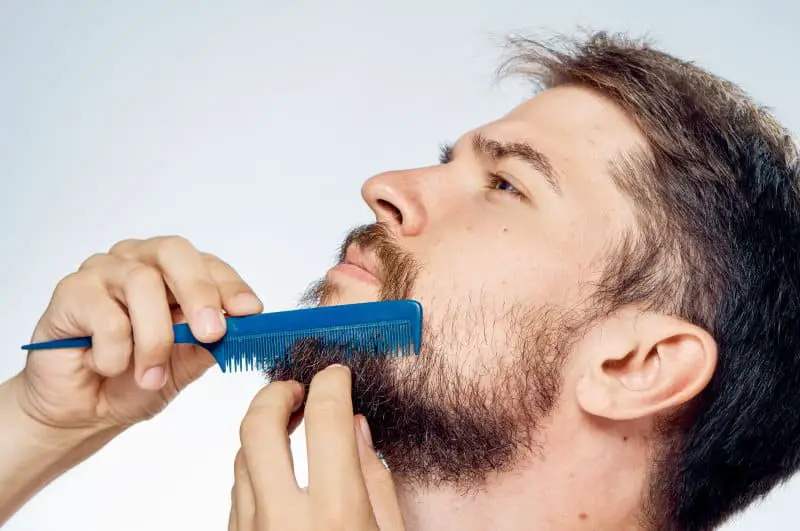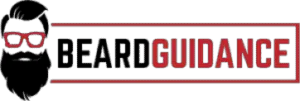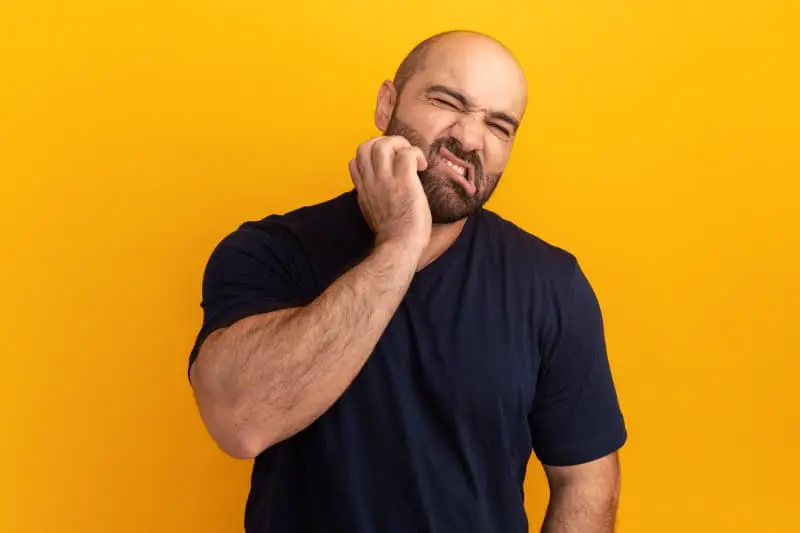It’s the bane of all new beardsmen, young and old alike. You’re starting with a baby-soft face. You’re pumped to get those face follicles growing, but then it begins: the scratching, the burning, the irritation, the bumps. Suddenly, you’re rethinking the entire idea of growing out your beard. Can anything be done to stop beard itch when your face mane is growing?
On average, all men can expect to experience some annoying beard itch while their facial hair grows. You can mitigate this with proper cleaning, drying, and moisturizing. More extreme cases might require you to start over or consult a doctor about an underlying skin condition.
If you’re suffering from new beard itchiness, keep reading for a detailed discussion of its causes. You’ll also learn a wide range of remedies.
What Causes the Itch?
Beard itch is completely normal. It’s one of the little – and sometimes not so little – annoyances that come with growing facial hair, right up there with patchiness and off-odors. It follows that most beard itchiness, especially while your hair is growing, has anodyne explanations.
These include:
- Sharp stubble – You aren’t imagining it: the hair that emerges when you stop shaving is sharp. When you shave, your razor leaves a sharp edge on the follicle end. Once that follicle emerges again, it is common for the edge to bother your skin.
- Dry skin – This is the most common cause of itching, both on your face and anywhere else. Lack of hydration leads to flaking, dandruff, and the need to scratch.
- Ingrown hairs – They can be painful, but more often, they are just plain irritating.
- Allergic reaction – You might be putting something on your new beard that doesn’t agree with your skin.
- Skin blemishes – Sometimes newly-bearded dudes get lax with their face care, resulting in pimples and rashes. These exacerbate the itch.
- Seborrheic dermatitis – This skin condition, which is common for people with oily skin, can lead to redness and irritation.
- Skin infections like tinea barbae or folliculitis – Caused by bacteria and fungal infiltration, these infections can result in inflammation, bumps, and a lot of itchiness.
We want to be clear from the outset, nearly all beard-growth-related itching stems from dull causes like skin dryness and ingrown hairs. Medical conditions and skin infections shouldn’t be discounted. However, you also shouldn’t automatically assume you need medical intervention because of some aggravating scratchiness under your new facial hair.
When Does Beard Itch Stop?
Unless your beard itch is the result of a larger skin condition, time might well be the best remedy.
On average, a new beard stops itching after one to two weeks of growth. Of course, this is largely contingent on continuous proper beard and face care. We will lay out what this means for the itching pelt-grower in a moment.
In the interim, we recommend that you look in the mirror each morning and repeat the adage, “this too shall pass.” After a couple of weeks, that skin irritation under your facial hair will likely be a distant memory.
Can it be Prevented Altogether?
It’s not likely that you can fully prevent itching during beard growth. Everyone’s skin is susceptible to some level of irritation. For some people, a little dust can lead to rosy flesh and annoying bumps. Other guys can tromp through heavy vegetation in shorts and only experience some minor scratching.
All this is to say, your face is likely to get irritated when it undergoes a change like the sudden emergence of new, coarse hair. Your natural susceptibility to irritating stimuli will determine the level of itching. Complete prevention is a pipe dream for most beardsmen.
However, every guy can take certain steps to mitigate beard itch before it becomes unbearable.
What NOT to Do to Address Growing Beard Itch

Before we get into some handy tips for reducing beard itch during growth, let’s first discuss what not to do. The following rash actions (pun intended) will not only fail to address the problem. They will probably make it worse:
- Don’t shave irritated skin – Remember, your new beard might be the stimulus for your itchy face, but it isn’t the cause. That might seem like a semantic argument, but it isn’t. Removing your beard will not stop the skin irritation below. Also, a combination of razor burn and astringent shaving products will probably compound your problems.
- Don’t use harsh chemicals – This is a good rule in general, but it’s key to addressing irritation. Dry skin is at least partly to blame for the itch. If your rinse your face with astringent chemicals, particularly alcohol, it will further dry out your skin. This, in turn, will prompt your sebaceous glands to produce more natural oil, which can lead to pore obstructions and additional irritation.
- Don’t scratch your face – It will only relieve the itch momentarily, and it will exacerbate any rash or redness on your already sensitive face.
Now, that we know what actions should be avoided with an itchy face, let’s explore the positive steps you can take to relieve your newly scruffy mug.
Tip #1: Washing
As an adult man, you surely understand the importance of keeping your face clean. Yet, even the most diligent guy can neglect washing his cheeks, especially when growing in some quality stubble. If you’re letting your vacation beard grow in, you might also be slacking with the face scrub.
Since residual grit and oil can lead to face blemishes and ingrown hairs, it’s a good idea to buy yourself a combination face and beard cleanser with moisturizing qualities.
We especially love Cremo Mint Blend Beard and Face Wash. Cremo is a fantastic men’s grooming brand that doesn’t skimp on quality ingredients. This excellent scrub incorporates sweet almond oil, tea tree oil, and peppermint, a perfect combination to soothe and fortify your sensitive face.
Tip #2: Hydration
While dry skin is the most common cause of new beard itch, it is happily also one of the easiest issues to fix. Countless effective face and beard moisturizers will soothe your itching skin and protect it from further irritation.
We recently explored which face lotions can be used on a beard and which cannot. As a general rule, if you’re rocking anything longer than short stubble, you need to search out something that will absorb as cleanly into your facial hair as it does your skin.
What should you be looking for then? On average, the best face moisturizers for hirsute dudes contain significant quantities of emollient oils. These oils sink into skin and hair, filling in gaps and abrasions. Great emollients in face and hair products include, but aren’t limed to:
- Argan Oil
- Castor Oil
- Coconut Oil
- Jojoba Oil
- Sunflower Seed Oil
If you see these oils in your face moisturizer, it will be fantastic on your new chin-pelt as well.
If, on the other hand, your moisturizer is composed entirely of petroleum oil, mineral oil, paraffin, or beeswax, it will not absorb. These are occlusive oils, meant to seal off and protect your skin. These products will leave clumps and oily streaks in your beard.
Hydration products with the emollient oils listed above tend to be pricier than their less absorbent competition, but you get a lot for the extra money. If you use an emollient-rich moisturizer daily when growing in a new beard, the itch will be significantly less pronounced.
Tip #3: Careful Drying and Grooming
It’s all well and good to rinse and moisturize your face and beard, but if your leave your facial hair wet, you might be undoing much of the good work your washing accomplished.

Beard hair is naturally coarse. Letting it drip dry after a wash only accentuates this coarseness. Your goal in the early days of beard growth should be to soften the sharp, emerging stubble. To do this, you need to pat your facial dry immediately after showering or rinsing at the sink.
While you’re at it, you should get in the habit of tending to your new beard with dedicated grooming tools and products. If you haven’t already, invest in the following beard care items:
- An emollient-rich beard oil and/or beard balm
- A beard brush with strong bristles
- A wood beard comb
Post-wash application of beard oil or balm, followed by some assertive-but-gentle styling with your brush and comb, will do wonders for softening your itchy beard. These practices also feel pretty nice on itchy skin, giving your face some quick – yet productive – relief.
Tip #4: Reassessing Your Face Products
Let’s say you prepared admirably for a new beard, buying lots for washing, conditioning, moisturizing, and styling products for your growing facial hair. If you find that, after doing all the cleaning, hydrating, drying, and grooming we recommend, your face is even more itchy and red, these new products might be an issue.
Persistent beard itch is sometimes the result of an allergic reaction to topical ointments on your face. Introducing multiple new cleaning and styling products to your face at once might have tripped off a previously unknown allergy.
If you suspect a particular product contains an ingredient that you’re allergic to, discontinue use for a few days and see if the itching lessens. If this doesn’t help, try discontinuing all your new face products, then reintroduce them one by one.
The continuing irritation might not have to do with a specific allergy. Your skin might just be sensitive to abrasive agents like the essential oils in many beard products. Reducing exposure to these products may do the trick in easing redness and scratchiness.
Tip #5: Supplements and Diet Changes
The question of whether supplements like Vitamin E or Biotin help grow and thicken facial hair is a dicey one. However, if you are in the process of growing a beard and find that your budding face follicles are severely irritating, there are dietary and supplementary options that might soften this facial hair.
In the end, what we put into our bodies has as large an effect on our beard growth as what we put on our faces.
To begin, many new beardsmen focus on what they eat. Here is a partial list of foods that help promote healthy facial hair growth:
- Protein-rich foods, especially nuts, eggs, and fish
- Iron-rich foods like kale
- Vitamin C-rich foods like citrus fruits and potatoes
- Avocadoes, nut spreads, and seeds, all of which contain amino acids and good fats.
- Sunflower seeds and almonds for Vitamin E
You can augment these positive dietary choices with multivitamins that include Vitamins B and C, Calcium, Zinc, Biotin, and Niacin.
Food and supplement choices won’t solve beard itch by themselves, but in conjunction with proper washing and hydration, they could help your new beard become fuller and softer. This is a good thing in and of itself, but it’s also key to relieving your itchy face.
Tip #6: Starting Over
If you find that the itchiness and redness in your face are getting worse, you may want to consider shaving your new beard and starting over. This is especially the case if you’re experiencing multiple ingrown hairs, raised rashes, or persistent acne.
We know this might be a bummer, but take heart. Shaving your facial hair doesn’t mean that you can’t regrow it later. Most likely, you are facing an underlying skin problem that is exacerbated by the new face follicles emerging on top of it.
Removing your beard gives you a clearer path to address any skin conditions and allows your face to repair itself as needed. Be aware, sometimes irritation, rash, and blemishes become worse after a full shave. Beard removal is just as disruptive to your face as new beard growth. However, you can relieve this quickly with a natural, non-abrasive post-shave balm and face moisturizer.
Once you’re back to sporting a healthy fresh face, you can start growing your facial again with a careful eye on mitigating skin irritation this time around.
Tip #7: Medication
If you think you might be contending with something more significant than dry skin or sharp stubble, you may want to discuss your facial itch with a doctor. Certainly, no one ever died from beard itch – no matter how agonizing it was – but if you have a bacterial or fungal infection, a medical professional can recommend medication to fix it quickly.

For example, if your doctor finds you have a bacterial infection, they might prescribe Mupirocin. For fungal infections, you might get a prescription for an antifungal drug like Sporanox or Lamisil. Dermatitis, even in severe cases, can be addressed quickly with Clobetasol.
Even if your medical provider doesn’t identify a clear infection, they can potentially provide you with medication to relieve your symptoms while your face heals. This might come in the form of a cream with urea and lactic acid to prevent flaking or a mild topical hydrocortisone.
We understand there’s natural trepidation to going to the doctor. No one likes to think there could be something wrong with their body. Even so, the relief you will feel identifying a cause and assigning a drug regimen to fix it will be a relief.
In the end, your doctor might be able to diagnose a condition by not need to prescribe a drug to treat it. This, too, is fairly common. Folliculitis, for example, can sometimes be treated by forgoing shaving for three to four weeks, something you were planning on doing anyway!
Tip #8: Lasers and Scalpels
Sometimes, there are more pernicious beard-growth issues that go beyond at-home treatments, diet, or medication. Hair follicles, particularly those in the face, are peculiar things. Most of the time, they position new hair straight out from the skin. Sometimes, though, hairs grow out in odd angles from your face.
Even in the best of circumstances, this can cause discomfort. When facial hair grows relentlessly into and against your skin, it can go beyond itching into outright pain.
Beardsmen deal with ingrown hairs all the time. Often, a warm compress and a pair of tweezers will fix it. However, if facial hair-related irritation occurs en masse, constantly, and to the point of infection, it might be time to talk to your doctor about medical intervention.
To be clear, we aren’t talking about the kind of intervention that involves general anesthetic or in-patient care. Medical hair removal occurs in a dermatologist’s office with a laser or a scalpel. You might not need any painkillers, and you will be back out in the world with little more than a bandage on your face in an hour or so.
While hair removal might seem extreme for beard itch, it can be a fantastic solution for a malign skin condition. Moreover, this solution is permanent. No more ingrown hairs from the treated area, and no more ungodly scratching.
The Bottom Line
Nothing undercuts the excitement of growing a new beard like the annoyance of persistent beard itch. For most guys, the irritation that comes with growing facial hair will disappear quickly, especially with proper washing, moisturizing, and grooming.
Even if your beard itch is the result of a more intractable skin condition, the solutions to stop it are generally simple and quick.
Curious why beard hair looks and feels different from the hair on your head? Check out our article on facial hair’s similarity to other hair on your body.

